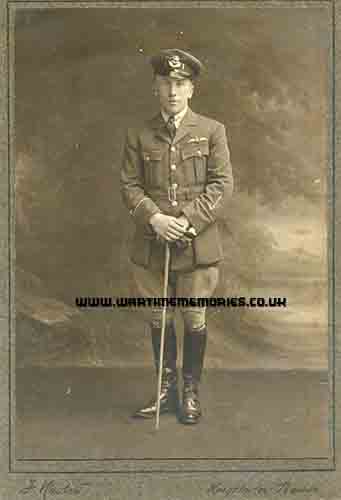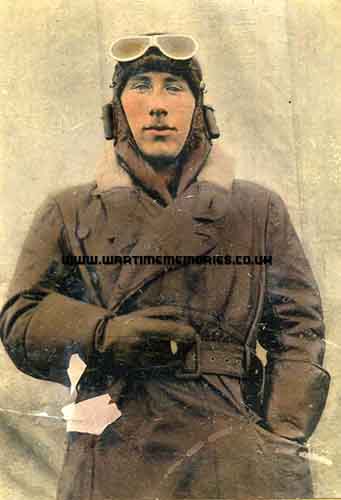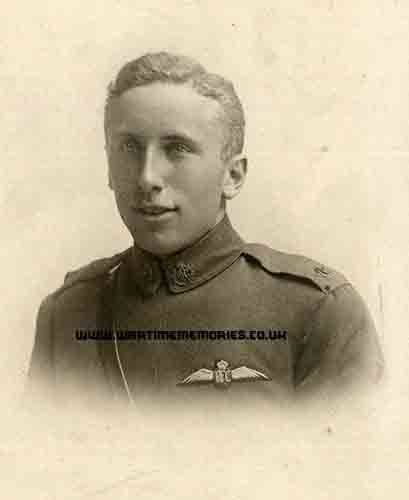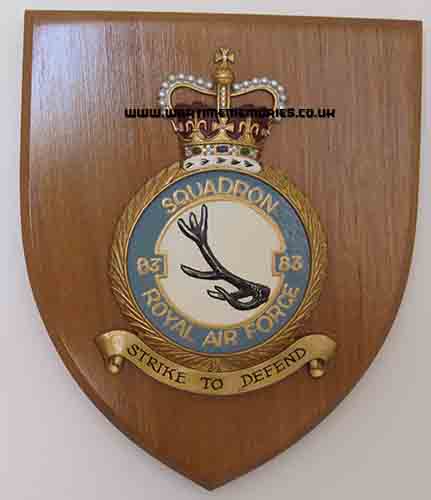Additions will be checked before being published on the website and where possible will be forwarded to the person who submitted the original entries. Your contact details will not be forwarded, but they can send a reply via this messaging system.
please scroll down to send a message
F/O. John Collier Frederick Hopkins
Royal Flying Corps 83 Sqdn.
from:Rypeck, Long Ditton, Surrey
My father Jack Hopkins left school in 1916 and signed up with the Honourable Artillery Company on 30th October 1916 where he was placed in the reserve Battalion, his service number was 9287. In May 1917 Jack was commissioned into the Royal Flying Corps (RFC). His service number was 12073. The need for pilots was urgent and losses were high. Consequently training occurred hastily and involved gaining experience on different aircraft. His own record of events is almost a catalogue of the aircraft available then. He flew solo on a Maurice Farnham Shorthorn at Shoreham, trained on Avros and Sopwith Pups at Dover, obtaining his wings in July. At Wye he flew Sopwith Camels after which he served on Home Defence at Hornchurch on Sopwith 11/2 Strutters.
At Dover his fighting instructor was James McCudden who became the most famous fighter pilot of the war earning the Victoria Cross in April 1918. Jack recalled that he was a brilliant pilot who enjoyed demonstrating the abilities of an aircraft by doing “hair-raising stunts round the aerodromeâ€. Sadly, McCudden was accidently killed over his aerodrome not long after he received his award.
Ultimately Jack was to serve as a night fighter on FE2B aircraft. This machine looks strange today with its propeller behind the cockpit. A front section, the nacelle, was for the observer who usually operated the machine gun and released the bombs singly using very simple equipment although the pilot or observer often lifted a bomb over the side by hand and dropped it. The cockpit and nacelle had no cover, so the crew must have been extremely cold.
Jack’s night flying training commenced with a posting to Marham in Norfolk in November 1917 followed by a posting to 83 Squadron at nearby Narborough then an overseas posting with the Squadron in March 1918 to Auchel in northern France. Most aircraft of the time could not fly long distances so could not attack from Britain.
When making the change to night flying Jack was initially nervous as he tackled the business of taking off while dazzled by flares along the runway and so was unable at first to see the horizon. The latter was very important at night to enable the pilots’ sense of balance to be maintained because they relied on this to fly the machine properly. No sophisticated instruments were available to help them in those early days of flying. All they had of any real use were an air speed indicator and a rev indicator. It was also important to gain enough height before making turns because, if not correctly done, the aircraft could stall and, if too near the ground, recovery was not possible and a crash was inevitable. Landing an aircraft at night also required new skills, particularly having to judge the distance of the aircraft from the flare path in order to avoid reaching the runway too early or too late.
Soon after arrival in Auchel the Squadron started bombing German structures such as aerodromes and railways. Reconnaissance was another valuable activity and photography was very important in this regard. Despite the unsophisticated cameras available at that time, RFC aerial photographs came to be regarded highly during the war. Jack discovered that much could also be learned from visual observation and remembered a mapping officer who flew out each night and made a mental picture of the ground. On returning he painted a map on large sheets of paper salvaged from the blue sugar bags they used at that time. Jack considered these maps to be surprisingly realistic and helpful in locating places they were ordered to attack.
Jack’s active service in France occurred during the last German offensive in March 1918. By early May some Germans set up a base within site of the Auchel aerodrome and began to attack it with artillery fire. This led to evacuation to a safer location joining with 101 Squadron. In the ensuing confusion little attention was paid to updating the men from Auchel regarding differing procedures. Unfortunately for Jack this led to his making an error during takeoff on his first mission at the new base and, with a full load of bombs, could not gain height properly. The plane hit a haystack in an adjoining field and cartwheeled several times before coming to rest. None of the bombs exploded but Jack was severely injured and spent several months in hospital, by which time the war was over. However, once he recovered from his injuries he was posted to 199 Squadron, Harpswell where he was an instructor on FE2Bs until his discharge in May 1919. Much later, in September 1972, the Imperial War Museum made a sound recording of Jack’s recollections of his night flying experiences which can be accessed by visitors to the museum.



